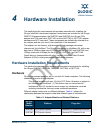
Draft
Step-by-Step Installation Checklist
Software Installation
3-2 Preliminary IB0056101-00 G.02
S
Software Installation
The following steps summarize the basic QLogic OFED 1.4 software installation
and startup. These steps must be performed on each node in the cluster:
1. Make sure that the HCA hardware installation has been completed
according to the instructions in “Hardware Installation” on page 4-1.
2. Verify that the Linux kernel software is installed on each node in the cluster.
The required kernels and supported Linux distributions for both QLogic
InfiniPath and OpenFabrics are defined in Table 5-1.
3. Make sure that your environment has been set up as described in “Setting
Up Your Environment” on page 5-3.
4. Download your version of the QLogic InfiniPath/OpenFabrics software from
the QLogic web site to a local server directory. See “Choose the Appropriate
Download Files” on page 5-4.
5. Install the selected packages on each cluster node using the corresponding
method as described in one of the following: “Install QLogicIB-Basic with the
Installer Tool” on page 5-7, “Using rpm to Install InfiniPath and OpenFabrics”
on page 5-14, “Install QLogic OFED User-level Software with the rpm
Command” on page 5-17, “Install QLogic OFED Using Rocks” on page 5-20,
“Install QLogic OFED Using a Platform OCS Kit” on page 5-22, “Install
FastFabric Software CD/ISO Image” on page 5-22.
6. The system can be rebooted after all the software has been installed.
7. The configuration file for the ib_ipath driver is set up correctly at
installation and is loaded automatically during system boot once the RPMs
have been installed. However, if you wish to change the configuration file,
see “Managing the InfiniPath Driver” on page 6-15.
8. If you want to configure the optional OpenFabrics driver ipoib, and you
have not configured it yet with the Install tool, or if you have used the rpm
install method, configure it as described in “Configuring the IPoIB Network
Interface” on page 6-2.
9. If you want to use the optional OpenFabrics services (opensm, srp,or
VNIC), configure them as described in “OpenSM” on page 6-3, “SRP” on
page 6-4, or “SRP stands for SCSI RDMA Protocol. It was originally
intended to allow the SCSI protocol to run over InfiniBand for Storage Area
Network (SAN) usage. SRP interfaces directly to the Linux file system
through the SRP Upper Layer Protocol. SRP storage can be treated as
another device.” on page 6-4.
10. Check the system state by observing the LEDs. See “LED Link and Data
Indicators” on page 7-1.


















